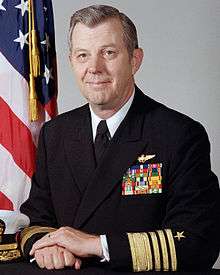James B. Busey IV
| James Buchanan Busey IV | |
|---|---|
 Admiral James B. Busey IV | |
| Nickname(s) | "Jim" |
| Born |
October 2, 1932 Peoria, Illinois |
| Allegiance |
|
| Service/branch |
|
| Years of service | 1952 - 1989 |
| Rank |
|
| Commands held |
Vice Chief of Naval Operations VA-216 VFA-125 NAS Lemoore |
| Battles/wars |
Cold War Vietnam War |
| Awards |
Navy Cross Defense DSM (3) Navy DSM (3) Legion of Merit (5) Distinguished Flying Cross (3) Bronze Star Medal |
Admiral James Buchanan Busey IV (born October 7, 1932) is a retired United States Navy four star admiral.[1] He served as Vice Chief of Naval Operations (VCNO), from 1985 to 1987 and as Commander in Chief, U.S. Naval Forces Europe/Commander in Chief, Allied Forces Southern Europe (CINCUSNAVEUR/CINCSOUTH) from 1987 to 1989.
Early years
James Buchanan Busey IV was born on October 7, 1932 in the city of Peoria, Illinois. In January 1952, Busey entered the U.S. Navy and attended the basic training at Boot Camp of Naval Station Great Lakes, Illinois. In March 1953, Busey was chosen to Aviation Cadet Training Program at Pensacola, Florida.
During the years 1967, Busey served at various Naval posts, including Naval Air Station Cecil Field or Naval Air Station Jacksonville. In July 1964, Busey attended the Naval Postgraduate School in Monterey, California and earned there his BS and MBA degrees.
Vietnam War
In January 1967, Busey was transferred to the U.S. Attack Squadron 163 ("Saints") and served as a pilot in Vietnam War. During combat near Hanoi, North Vietnam, Busey commanded the group of six aircraft with the task of bombing the Hanoi thermal power plant.
Despite the damage of Busey´s aircraft by North Vietnamese Anti-Aircraft guns, he regained control of his plane and continued his mission. Busey destroyed the target and returned to USS Oriskany. For this action, Busey received the Navy Cross.[2]
His other decorations from Vietnam War, including Legion of Merit with "V" Device, three Distinguished Flying Crosses, Air Medal or Bronze Star Medal with "V" Device.
Retirement
After retiring from the navy, he served as the chief administrator of the Federal Aviation Administration from 1989 to 1991.[3] He then served as United States Deputy Secretary of Transportation from 1991 to 1992. Afterwards, he became a board member at Curtiss-Wright until 2008.[4]
Awards
 | |||
References
- ↑ "Public papers of the Presidents of the United States, Volume 2"
- ↑ "Valor awards for James Buchanan Busey IV - Hall of Valor". militarytimes.com. Retrieved 2012-11-28.
- ↑ "Larger role for aviation center" The Telegraph (Nashua). 20 December 1989
- ↑ http://ir.curtisswright.com/releasedetail.cfm?releaseid=308067